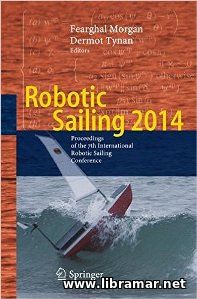 The publication contains the proceedings of the Seventh Conference on Robotic Sailing which was held in 2014; the volume includes numerous interesting works presented by the researchers from all around the world relating to both future and current challenges in the development of the various autonomous sailboats.
The autonomous sailing robots are the boats that only use the wind force for propelling with neither any actual human assistance nor any sort of remote control. The type of sailing in question offers the great potential of long-term and range autonomous solar, wind- and wave-propelled devices that are also carbon neutral. Such devices would greatly contribute to the monitoring of various important data, for example ecological, hydrographic, environmental conditions and other. Moreover, such robots could also be utilized for monitoring the traffic, assistance, surveillance, security plus rescue purposes.
However, they are still very dependent on the wind and sea conditions that are subject to the rapid change, and this is what in fact presents a serious challenge for the route planning, control of stability and avoidance of possible collisions. We recommend to treat the book as a definitely interesting and also quite informative publication for every robotic sailing enthusiast willing to be kept updated with the very latest technological developments and advances in the subject field.
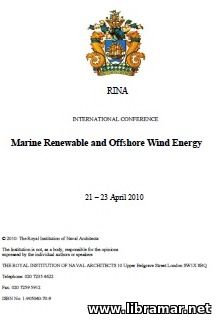 Another conference, this one dedicated to the Marine Renewable & Offshore Wind Energy - RINA International Conference - 2010. The opening document of the papers included in the set discusses the modern situation with the offshore wind development. It it critically important to underline that the experience could easily get transferred from the more mature offshore industries like oil and gas industry.
The team of authors of this article argued that the today's challenges and opportunities involved are multi-faceted and it would imply a serious need for the multi-disciplinary approach for proper assessment of the risks as well as optimization of the returns. The VCA, i.e. Value Chain Assessment is introduced, an the most adequate methodologies for optimization of the balance between risks and returns. Last couple of decades have demonstrated quite significant increase in the potential/implementation of the developmental and research projects relating to the wind energy.
The demand for subject type of renewable energy made the participants of the industry to look for new resources offshore. Subject trends have resulted in the implementation of the new technologies in cases where a relatively limited of experience data s possessed... Recommended for people willing to be updated with all recent developments in the industry...
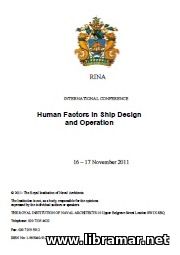 All articles of the International Conference, RINA. One of the ways how the human element makes an impact on a large scale is through inclusion of ergonomic requirements in the Rules published by Classification Societies. This can usually be achieved by either introducing these specific requirements into the Classification Rules or by making the existing Rule requirements with human element implications more explicit.
However, surveyors who assure Rule compliance, often have quite poor or even no any knowledge of the human element... The present pack contains numerous papers presented during the International Conference held in 2011. It starts with the paper describing the human element competency that is required for design appraisal, followed by the documents covering the human factor role in the investigation of marine casualties, human factor design, extended simulation runs and performance of seamen, noise effect on human performance, performance and fatigue issues in bridge and ECR watchkeeping, perception of risk, mapping of work areas, habitability assessment, shock mitigation seat test/evaluation, marine ergonomic design enhancement though digital human modeling, crew innovation on board short-sea vessels etc.
 This is a nice compilation of the proceedings of the papers that have been presented in the course of the Third ISSW and summary of discussions. One of the main objectives of that event was to promote the maximum possible exchange of technical information directly related to the research and developments in ship stability as well as operational safety.
This may be achieved through the in-depth discussions by the world respected experts. The first of the papers provides a sort of intro to the numerical modeling of the vessel motions and usage of such models in the analysis of the ship's intact stability. The author of the article has presented a good discussion of various important and actual aspects that shall form a part of the whole process of modeling, namely the ship system, environment, excitation and response, supplemented with a very brief overview of the techniques used for modeling of the hydrodynamic forces.
The main emphasis has been put on quality assurance and validation of various numerical modeling techniques. Among the topics that have been covered during that workshop there were application of various non-linear systems dynamics to vessel stability, numerical/physical modeling of intact/damage stability, some special ship stability problems etc.
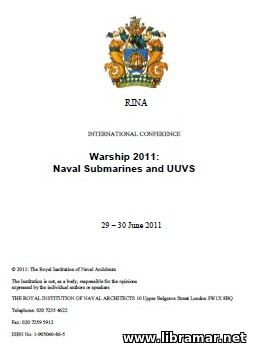 RINA International Conference - Naval Submarines and Unmanned Underwater Vehicles - 2011. Topics discussed in the course of the conference - Towards an automated active unmanned underwater vehicles docks on a slowly moving submarines, a submarine concept design, underwater gliders, evaluation of the maneuvering performance of the x-plane submarines, hydrodynamic design implications for submarines operating close to the surface, United States submarine concept design tool, construction materials for small sized submarines, alternative propulsion options for nuclear underwater vehicles, and many more.
Let us start with the first one, dedicated to the development of the integrated SES (submarine escape systems) - it provides readers with the review of the tower escape systems, addresses the geometry and ergonomics of the tower, pressurization, flood and draining matters, testing, acceptance and further support. The submarine escape is considered the very latest resort in case of the underwater vehicle becoming fully disabled - though rescue is of course the preferred option in the majority of instances, it may not be possible in some cases. Here are the operation and acquisition requirements...
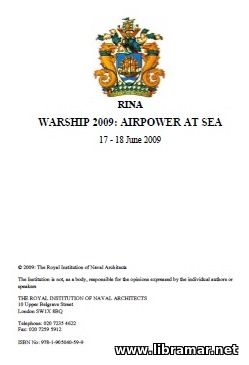 RINA International Conference - Warships 2009. This compilation contains of the selected interesting topics that were discussed in the course of the subject conference, for example Aircraft tie-down points for the affordable aircraft carrier - Introduction - Significance - Design approach - Cost savings - Meeting the requirements - Conclusions; Development, design of the rudders/propellers as well as hydrodynamic design of the aircraft carriers of Queen Elizabeth class; Optimizing the ship-air vehicle interface using the simulation method; Frigate aviation of the future; Real options reasoning in defense acquisition; The vessel design challenge of naval UAV (unmanned aerial vehicles).
The opening topic was dedicated to the development of the world famous aircraft carriers, meaning the ones belonging to the "Queen Elizabeth" class. The corresponding paper presented at the conference, provided the participants of the event with brief but thorough technical description of the key aspects of the advances involved, and also describes the associated alliance arrangements.
The shipbuilding strategy applied in that case did involved the construction of the big fully outlined blocks at different locations throughout the country; subject blocks were then transferred to Rosyth for assembly and integration...
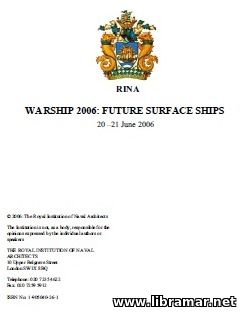 Warships - RINA International Conference - 2006. The reporters addressed following interesting topics in the course of that international conference - modeling maritime and warship survivability, operational experience with Sea Fighter FSF1, design issues concerning the high-speed adaptable littoral warfare, power and propulsion for the new generation of global combatant, survivability of the warships, tools to reduce vulnerability at the earliest stages of the ship design, multipurpose versus modularity, some affordable ways of protection of vessel systems against fragments and blast, and many more... the publication opens with the article dedicated to the new family of warships by VT Shipbuilding.
The significant increase in the costs over last decades for both new construction and upgrades/modifications and retaining in active service of the destroyers and frigates have resulted in the problems that are currently experienced by many Navy fleets when maintaining adequate ship hull numbers to perform various assigned tasks. The approach that is currently used today, implying production of the multi-purpose vessels may appear too costly to address imminent problems of fleets becoming lower and lower over the next years...
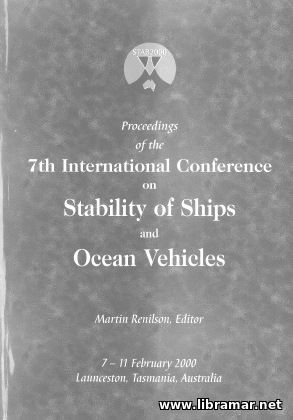 The series of international technical conferences held with the purpose of improvement of the Stability of Ships and Ocean Vehicles has been running since 1975, and, on behalf of the National Committee, I am very proud that Australia was chosen to host the 7th conference in February 2000.
The objectives of the present conference series is to promote a full exchange of methodologies and ideas related to the stability of ships as well as ocean vehicles. It creates practical opportunities to all marine industry pros, including ship constructors, naval architects, officers of the various certifying and inspection authorities, regulatory agencies, capsize prevention researchers, ship and platform owners, and others to present, discuss and listen to improvements in capsizing prevention for all sizes and types of floating structures.
The most important aspect of any floating object is its ability to remain afloat and upright under all expected conditions. Even this most basic of requirements can elude professionals in the field, usually with very serious consequences. It is therefore vital that all of us who are concerned with the operation and design of ships and ocean vehicles devote the utmost effort to ensuring they are as safe as possible. Only by sharing knowledge and experience can we continue to improve safety, which is the primary motivation for this important conference series.
|







